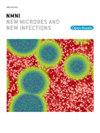狼牙亨尼帕病毒(LayV)作为一种新兴的人畜共患疾病:综述
IF 5.4
Q2 INFECTIOUS DISEASES
引用次数: 0
摘要
亨尼帕病毒是正粘病毒亚科中的一个属,该亚科包括几种对公共卫生构成重大威胁的新出现病毒。该病毒属的主要成员亨德拉病毒和尼帕病毒是极具毒性的人畜共患病毒,可引起神经和呼吸道感染并在人类中暴发。最近发现的狼牙亨尼帕病毒是一种与漠江亨尼帕病毒(MojV)在系统发育上相关的新型亨尼帕病毒,与中国主要农业工人的发热性疾病有关。必须在世界范围内以开放和协作的方式进行主动监测,以减少这种新病毒造成健康危机的可能性。需要更多的研究来解决剩下的困难。本文章由计算机程序翻译,如有差异,请以英文原文为准。
Langya henipavirus (LayV) as an emerging zoonotic disease: a mini-review
Henipavirus is one of the genera in the Orthoparamyxovirinae subfamily, which includes several emerging viruses that pose a major public health threat. The predominant members of the virus genus, Hendra and Nipah viruses, are extremely virulent zoonotic viruses that cause neurological and respiratory infections and outbreaks in humans. The recently discovered Langya henipavirus, a new henipavirus phylogenetically related to Mojiang henipavirus (MojV), has been associated with febrile illness in patients from China who are mainly agricultural workers. Active surveillance must be conducted worldwide in an open and collaborative manner to reduce the likelihood of this new virus causing a health crisis. More research is needed to address the remaining difficulties.
求助全文
通过发布文献求助,成功后即可免费获取论文全文。
去求助
来源期刊

New Microbes and New Infections
Medicine-Infectious Diseases
CiteScore
10.00
自引率
2.50%
发文量
91
审稿时长
114 days
 求助内容:
求助内容: 应助结果提醒方式:
应助结果提醒方式:


